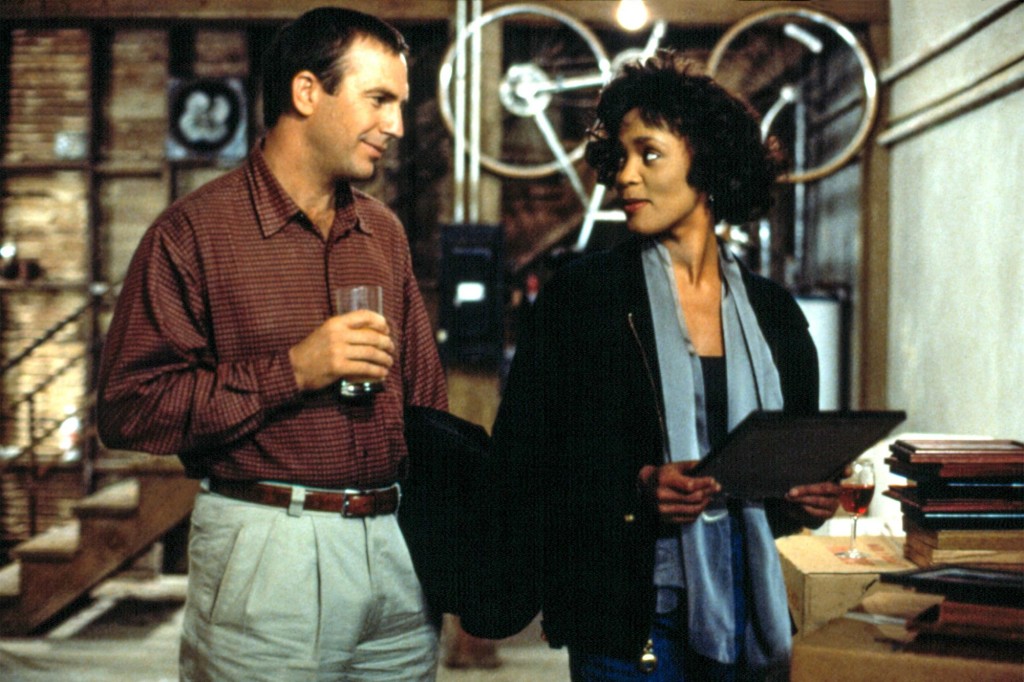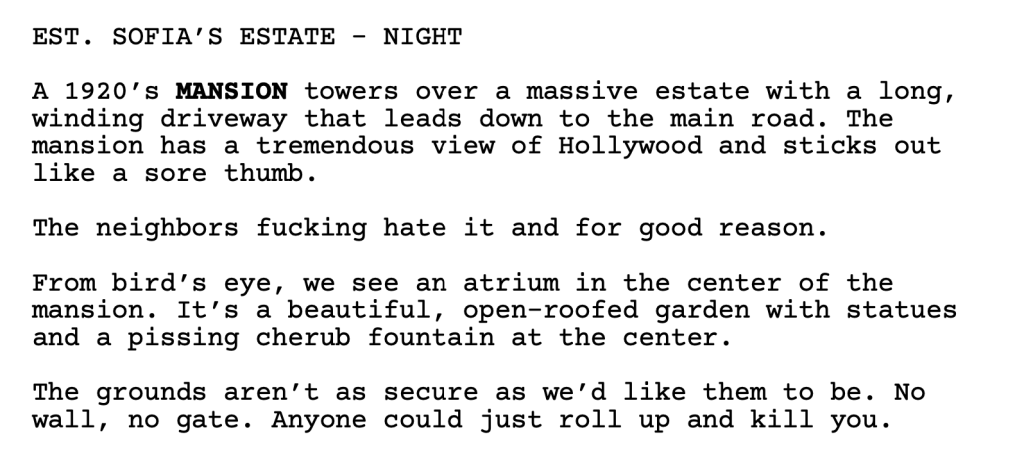We take a look at the Black List script that got the writer the job for the now infamous upcoming movie, Cocaine Bear
Genre: Home Invasion
Premise: A pop star, a basketball player, and a bodyguard will need to defend against a crazed fan and his cronies who invade her home.
About: This script received 11 votes on last year’s Black List. It is written by Jimmy Warden, who wrote the sequel to Brian Duffield’s “The Babysitter” and, more recently, the script to the much buzzed about “Cocaine Bear.” I’m assuming this script got Warden the writing job for Cocaine Bear.
Writer: Jimmy Warden
Details: 97 pages
There is a group of people out there who are OBSESSED with the 1992 movie The Bodyguard starring Whitney Houston and Kevin Costner. That movie may be only second to Goonies in number of scripts I get that are trying to remake past films.
I kind of understand it. Whitney Houston and Kevin Costner were such an untraditional pairing and those untraditional pairs are often what audiences become mesmerized by. Still, I’m not sure I understand the obsession people have with this film, an obsession that has clearly influenced today’s screenplay.
It’s 1994 and 40-something William Bell is a bodyguard for 20-something Sofia, a Grammy-winning pop star who’s part Lady Gaga, part Carmen Electra, and part Ariana Grande. One night, a crazed fan named Duerson shows up to Sofia’s mansion and when Bell answers the door, Duerson stabs him.
Cut to six months later and we meet Sofia for the first time. She saw pictures of a Dennis Rodman like basketball player named Devante Rhodes and did the 1994 version of slipping into his DMs (she got her people to contact him) and now he’s over at her place for some hanky-panky.
It’s clear that Sofia does this all the time. In fact, she’s got a drawer where she keeps newspaper clippings of all the celebrities she’s banged. Which is too bad because Rhodes likes her and wants something more. While the two chat, Bell shows up for the first time in six months. He’s back on the job finally and, this time, he’s not going to take crazed fans for granted.
That new approach will be tested because it turns out Duerson has just broken out of the crazy ward! He’s teamed up with a giant scary man named J.H. and a psychotic French woman named Penny to go right back to Sofia’s mansion and take what he wants!
Bell then gets a call from his new girlfriend, who’s babysitting his daughter. There’s a strange man outside their apartment (it’s J.H.) and she thinks he’s going to harm them. Bell has to leave Sofia and, as soon as he does, Duerson and Penny charge into the house and take Sofia hostage. If you’re wondering why a 6 foot 8 monster of a basketball player is unable to protect Sofia from these two little scrawny gnats, join the club!
J.H. is somehow able to kidnap Bell, his girlfriend, and his daughter (does this guy have like 12 arms?), drive them back to Sofia’s house, all in time for Duerson to reveal his plan: He’s going to marry Sofia! He’s even kidnapped a minister to officiate the wedding. Will Duerson succeed? Or will crazy win once again??
Today I want to make a distinction between the three ingredients that make up a screenplay: Writing, Craftsmanship, and Storytelling. You need to be good in at least two of the three to write a good script. But your goal should be to become good at all of them. Let’s take a look at what each consists of.
Writing – Writing is the way in which you construct your words, your sentences, your paragraphs. It’s the prose you bring to the script to make it pretty, clear, and visual. When you read the description of a room, that’s writing. When you read the description of a character, that’s writing. This is usually what you see in the novel world. Since words are the final form of the medium, most published authors are good at it.
Craftsmanship – Craftsmanship is the ability to incorporate screenwriting-specific tools in an effortless invisible way. For example, understanding that you have to make your main character likable then writing a scene that conveys that likability – that’s craftsmanship. Understanding that a good scene needs to start late and end early – that’s craftsmanship. Coming up with a flaw for your main character, incorporating a theme, knowing where to put the inciting incident – all of that is craftsmanship.
Storytelling – Storytelling is the creative side of the equation. It’s not about being a wordsmith. It’s not about technique. It’s about how imaginative you are. Are you coming up with exciting plot points and story developments? Are you building a unique world that feels fresh and new? Introducing a surprising twist, like the Mary Jane father twist in Spiderman: Homecoming, that’s storytelling. Constructing a really cool spaceship chase, like we got in the beginning of Star Wars, that’s storytelling. The slow and careful infiltration of a poor family taking over a rich family’s home in Parasite, that’s storytelling. Any time you come up with a great scene idea or a great moment for your latest script, that falls under storytelling.
The reason I bring this up is because a lot of writers look at a screenplay as one big blob of writing and therefore don’t know how to pinpoint their weaknesses and improve them. But if you apply this separation, you can better understand where your weaknesses lie.
When I started reading Borderline, I was impressed by the writing.
The interplay between detailed visuals and playful commentary made the pages enjoyable to read.
But the craftsmanship in this script is sorely lacking. For example, there is zero attempt to make Sofia likable on any level. Why would we like a cold hearted bitch who uses people for sex, is disgusted by them when they show vulnerability, then disposes of them after a single night?
The reason this particular component of craftsmanship is so important is because the whole movie is about protecting this woman. If we don’t like her, why would we care if she’s harmed or not? You know what I mean? That’s not a minor craftsmanship screwup. That’s a MAJOR craftsmanship screwup.
Don’t get me wrong, you can get away with making characters a$$holes. But not if the entire movie depends on us liking them.
Another part of craftsmanship is character consistency. Duerson is introduced as an off-the-rails lunatic who can’t tell up from down. He seems to have stumbled upon Sofia’s house at the beginning of the story, almost by accident. Then, after he escapes from the mental institution, he’s all of a sudden Tom Cruise, putting together a Mission Impossible style attack team, complete with kidnappings, misdirects, and time-sensitive coordination. Which is it? Can the guy barely tie his shoes or is he a mastermind?
The storytelling side isn’t great either. Warden makes one interesting choice later in the screenplay (spoiler) when he kills off the main character. But every other creative choice feels rushed, like it was conceived during a feverish 24 hour writing session. Good storytelling has meticulous setups and payoffs. We can tell the writer has a plan that he’s carefully building towards. We don’t get any of that here. It’s mass chaos, a bunch of sloppy story beats carelessly cobbled together.
If you like home invasion movies, you might want to give this a shot. And I suppose if you’re making an argument for Warden, he’s got a chaotic off-the-rails style that some people dig, which is probably how he got Cocaine Bear. But I just found the script to be messy. There was no sophistication to the storytelling at all. I couldn’t get into it.
[ ] What the hell did I just read?
[x] wasn’t for me
[ ] worth the read
[ ] impressive
[ ] genius
What I learned: CHARACTER INTRO DELAYS. One pet peeve I have is when a screenplay mentions a character before they’ve been introduced. For example, sometimes I’ll read a script where we get a voice over from a character – let’s call him “Jason” – who I’ve never heard of until that moment. JASON V.O.: “I grew up in a small town outside Dallas.” Or maybe we’ll meet a character who hasn’t been introduced yet on the other side of a phone call. Or as one of the characters in a family picture we’re looking at. In screenplays, it’s important that when a character comes into a screenplay YOU INTRODUCE THEM PROPERLY. You give them a capitalized name, an age, and some description. This is a cue to the reader that: This is a new character in the script! If you do it any other way, you risk the reader being confused. Of them thinking, “Wait, who is this person? Were they already introduced? Why don’t I remember them?” However, if you absolutely must delay the official character introduction, Warden shows you how to do it. Here’s the proper protocol for a character intro delay.




